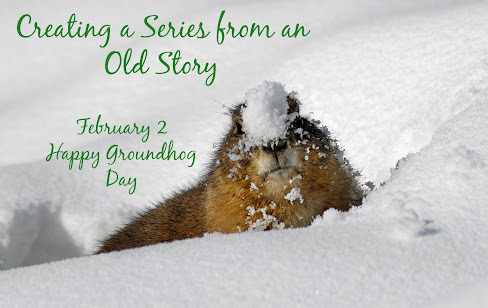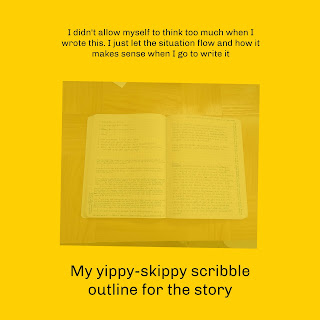Anyway, frigid temps aside, it seems like an eternity since I’ve written
something new for a book. And it’s all coming back to me now:
·
The characters
·
The setting
·
The conflicts
And countless other details.
I guess you know you’re chosen to be an author when
no matter how hard you try to put writing behind you, stories always seems to
find a way of creeping back into your mind, winding through your heart and
eventually, hijacking your fingers (or voice if you dictate) demanding
attention.
I have a story – a series really – that has followed
me for at least two decades. I found a floppy disk containing my first venture
into this story with the title and date neatly printed on the yellow plastic.
1999
Someday I’ll try and access that disk, when I find a floppy reader and have access to a WordPerfect program. It’s not necessary, though. I know exactly how I framed that story back then – dark, mysterious, aloof – exactly how the historical romance writers of the time wrote their bestsellers.
I’ve revisited this series from time to time with
little luck in finding a voice and a tone that felt right. Until now.
I’ve opened up a new binder in Scrivener and have
begun working on a new series reflecting my old concept. You might think “wow, piece of cake! The book
is essentially written. All I need to do is tweak here and there and I’m done!”
Mmm, not so easy. You see, all those years of simmering behind the scenes has
led to many changes in my characters and the series itself. I talked about brainstorming
ideas for this story/series back in October.
In just a couple of days, I had brainstormed and outlined 6 novellas to accompany
the original novels.
Fast forward to present day
I’ve started a new binder for my series. I’ve
incorporated all my notes so I have everything all in one place. I’ve even
scrounged around and found photos of characters to rekindle inspiration.
 |
| I use Moleskin for my daily planner. For my "bullet journal," I use any dot paper notebook I can find that's cheap!! |
If there’s anything I’ve learned over the years of
reading, writing, workshops, conferences, etc, it’s that you have to have a
plan. Not the plan for your character arcs or black moment, or all the other
elements of story.
There needs to be a plan in place for your SERIES.
A series needs a blueprint just as much as the first
novel. Think about your favorite author and your favorite series. Beloved
characters and villains probably made guest appearances in stories beyond their
own. Settings contained consistent details. Seasons and fashions progressed
with the stories. All of these details
go into a Story bible, but the creation of those details requires insight and
vision. Let’s look at a couple of blueprint points.
TIMELINES
When I think about my series of novels, I have 3
books, each occurring in succession with circumstances based on outcomes of the
previous book. That’s a relatively easy timeline to realize. Incorporating
historical events aside, I’ll need a simple timeline to make certain seasons,
holidays, schedules, etc all coincide.
When I look at my 6 novellas that compliment my
first book, they all happen simultaneously. I am looking at a period of a week
where I have dozen primary characters interacting with each other and, at
times, the characters of the featured novel. AND, the dozen primary characters
all have their own conflicts and desires that sometimes clash with their love
interest and characters not necessarily involved in the novella I’m working on.
Do I need to know where all these characters are at all times? Yes, I do!
CHARACTER PROFILES
Let me start by saying, I’ve never been a big one to
fill out the routine hair color, eye color, height, etc forms. When I write a
book, I’m dealing with 2 primary characters, and I can pretty well look at
their pictures and visualize the scene. When I start thinking about a series of
novellas that all wrap up in the same week, I better keep in mind which
character has the green shawl, the silver reticule, the blue satin slippers. This
may be a large estate, but people will interact and personal affects from one
character’s situation in one book must show up in another book if the detail is
noteworthy to any extent.
SETTING
In a prior lifetime, I was a licensed interior
designer. Blueprints and creating purposeful environments are still second
nature to me. I love researching the layout of an old manor house to see how I
can modify it for my purposes. Creating presentation boards remains a tool I
use to keep me in sync with the setting of any project. It’s fun; it’s
creative; it’s essential.
These are just a few story points in keep in mind
when formulating your next series. Or even, stand-alone book if you have a lot
of details to keep straight. Create your own “binder” either by hand or using
writing program like Scrivener.
Truth is, I’m not an organized person. I was desperate. I’ve modified Plato’s famous quote to fit:
Desperation
is the mother of invention.
I’d love to hear how you keep story details ordered
and accessible. Let’s brainstorm!!
Website: www.audraharders.com





.jpg)

What other country forecasts weather with a rodent?
ReplyDeleteThanks for the laugh this morning!!!
DeleteRight? And may I just add that the little rodent saw his shadow so brace up! 6 more weeks of winter. BRRRRRRR!
DeleteAudra
I love your organization, Audra!
ReplyDeleteWhen I'm working on a series, I set up my three-sided board (the kind you use for science fairs.) I make a map of the setting, brief character sketches on index cards, and the major plot points.
I put all these things on Scrivener, too. But the visual of the board is perfect - I can just glance at it to remind myself of those pertinent details.
But then this summer my virtual assistant and wonderful daughter-in-law will be putting together a series document for my cozy mysteries (Erica had a post on hers a few months ago.) That will be great. I can keep details straight for a three book series, but once I get beyond that there is too much information! And I'm thinking this series will go beyond five or six books and novellas. :-)
Mornin' Jan! I'm so happy to hear your cozy series is going to continue into perpetuity!! You just have to love a book with a cute Corgi!
DeleteI love the idea of the tri-fold board! Pictures of the setting in all forms in the middle section and pictures of the characters on the two side panels. Brilliant! I've always used my tri-fold for my scene layout with sticky notes on pink and blue (so original) to help me figure out the plot. I might have to invest in another tri-fold for the setting. I love using Scrivener to bank all my writing and research in one digital location, but nothing beats tactile creativity.
OUR VA (your DIL) created a master document for me to keep track of the characters and scenes. I love it. I've added pages for specific research per book. As I've mentioned time and again, I'm the poster child for scatter-brain. Having all these tools surrounding me helps keep my focus on the task at hand.
Bundle up, Jan! 6 more weeks of winter heading our way!
Audra
This is such a great post, Audra! I love your process! I work in a similar way. Kind of. One of the hardest things for me when I began taking my writing seriously was trying to figure out how it was "supposed" to be done. I finally came to realize that no two writers work in exactly the same way. While we can borrow this tool or that idea, each writer needs to build her own toolbox that works specifically for her own stories, her own voice, her own habits, her own lifestyle.
ReplyDeleteLike you, I find reference photos for my characters, setting, and any items important to the story. I do have worksheets that I fill out so I can see entire plot and character arcs at a glance. They are my own creation, the distillation of information from all the craft books I've read. I don't use Scrivener. I have shelves filled with actual binders that I feed with scraps of papers filled with ideas until I'm ready to start working on that project. That came from Don Aslett', "Get Organized, Get Published." He and I are both a little old school. Then I have an index card system I use that is something like the storyboards they use for animated movies. Did I mention old school? But then, I have an entire basement as my dedicated Writing Workshop, so I have the room to have all this stuff. I need the physical "stuff." Laying out the parts and pieces and moving them around allows me to see the story in a way that I can't capture on a computer screen. That's just the way my brain works.
And I just have to say, I'm not sure that the groundhog is a reliable narrator. Here in Kansas, we're hitting mid-fifties this weekend, and the robins have already come back. Hmmm ... groundhogs or robins? I'd rather trust the robins!
We've had robins around all winter - and the mess they're leaving on my deck makes me want the groundhog instead, LOL!!
DeleteTerri, you are a gal after my own soul. I need hands on, I need paper to work with, I need..., I need.... You get the picture. I'm fortunate to have a rather large room dedicated to my office to lay things out. I'm going to check Don Aslett out. Every how-to book can offer some nugget that fills in the missing pieces of my process. Thank you for the recommendation!
I have a love-hate relationship with Scrivener at the moment. Since they upgraded to version 3, trying to use the program efficiently with a PC is woefully frustrating. I purchased Atticus a few months ago to reformat a book and it has few bells and whistles - just my style and speed, LOL. They are improving the word processing side of the program slowly, but hopefully, I'll be able using that as my story writing go-to someday.
Always good see you, Terri!
Audra
Here in Nebraska it has been cold and windy as well, but we are heading into a weekend of 40's. I know I will be ready for spring. This was a good post, Audra. I mostly use binders and notebooks to keep track of details. I am not very good with technology and I think Scrivener would be too much of a learning curve for me.
ReplyDeleteSandy, we saw the snow weather map on the news last night. It looked like all of Nebraska was covered in white except the Omaha area. It's in the 40s here today, but I'm not seeing a lot of melting!!
DeleteWhen Scrivener was first released for PCs years ago, I had the brain-width to take classes and study it until it made sense. Now? Not so much, LOL. It's taking baby steps to figure out where all my old commands are and what in the world to do with the new stuff. I do enjoy using programs such as Scrivener though. Since I use MS Word and Excel for everything in my daily life, using a dedicated writing program for story-time makes my brain get into the manuscript groove. I just wish they'd stop making it bigger and better, LOL!!
I hope the nice weather sticks around for awhile! Sunshine is always a good thing!!
Audra
It is true. Omaha was about the only area that missed the big storm.
DeleteI loved your presentation board, Audra! Also, lots of great info in this blogpost! I use a whiteboard to create the plot in the beginning and then refer to that visual as I move through the story. Seeing it in a condensed form seems to help.
ReplyDeleteI agree with you, Debby. I need the details of my setting and characters in front of me, as well. I'd love to use a whiteboard but I've run out of wall space to hang one :)
DeleteI'm glad you enjoyed the post!
Audra
Great post, Audra! I could not imagine keeping all those details straight. But when editing, you've got to keep the details straight too. I've been known to do a word file of notes to keep track of characteristics just to make sure. If I was writing a multi-book series, I would probably do an Excel spreadsheet, with tabs, lol. This morning we woke up to snow! Enough to make the trip into work interesting, and the groundhog saw his shadow! Of course he did. But I'm still waiting on that one big snow. I want to make my snowman! I have my snowman kit all ready, but no snow to use it on...Hopefully one day soon!
ReplyDeleteThanks Sally! I'm glad you enjoyed it. Keeping the details of our stories in some semblance of order is an eternal quest, right? My VA created a spreadsheet to help me keep details straight across the multiple story lines. Bless her heart - in the most thankful way possible, LOL. Storyboards are an essential tool.
DeleteWishing for snow? Come to Colorado. I'll even help build the snowman - maybe an entire snow family!!
Audra
This comment has been removed by a blog administrator.
ReplyDeleteHey, Audra. Great post. I'm busy taking down the Groundhog Day decorations.
ReplyDeleteGlad to hear it, Mary! Gotta make room for all the Valentines hearts, LOL!
DeleteAudra